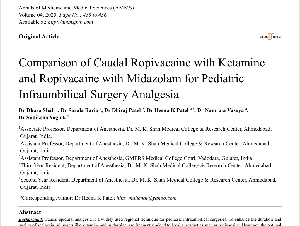Comparison of Caudal Ropivacaine with Ketamine and Ropivacaine with Midazolam for Pediatric Infraumbilical Surgery Analgesia
Authors
##plugins.themes.bootstrap3.article.main##
Abstract
Background: Caudal epidural analgesia is a widely used regional technique for pediatric infraumbilical surgeries. To enhance the duration and quality of analgesia, adjuvants like ketamine and midazolam are frequently added to local anaesthetics such as ropivacaine. However, the optimal combination offering superior efficacy and minimal side effects remains under evaluation. Aim: To compare the analgesic efficacy and safety of caudal ropivacaine with ketamine versus ropivacaine with midazolam in children undergoing infraumbilical surgeries. Materials and Methods: A randomized double-blind study was conducted on 130 pediatric patients, aged 1-10 years, undergoing elective infraumbilical surgeries. Patients were divided into two groups: Group A (n = 65): Ropivacaine 0.2% (1 mL/kg) + ketamine 0.5 mg/kg and Group B (n = 65): Ropivacaine 0.2% (1 mL/kg) + midazolam 50 µg/kg. Postoperative pain was assessed using the FLACC scale at various intervals, and complications were recorded. Statistical analysis was done using t-test and Chi-square test. Results: Demographic variables were comparable between both groups. Group A showed significantly lower FLACC scores at 2, 4, 6, and 12 hours postoperatively (p < 0.05), indicating prolonged and superior analgesia with ketamine. The requirement of rescue analgesia was reduced in Group A. Incidence of complications such as vomiting and fever was higher in Group B, though not statistically significant. Conclusion: Caudal administration of ropivacaine with ketamine provided longer and more effective postoperative analgesia compared to ropivacaine with midazolam, with a comparable safety profile. Hence, ketamine may be considered a more effective adjuvant for caudal blocks in pediatric infraumbilical surgeries.
##plugins.themes.bootstrap3.article.details##
Copyright (c) 2025 Dr Dhara Shah, Dr Sarala Baria, Dr Dhiraj Patel, Dr Heena K Patel, Dr Namrata Vasoya, Dr Sudiksha Yagnik

This work is licensed under a Creative Commons Attribution 4.0 International License.
Creative Commons License All articles published in Annals of Medicine and Medical Sciences are licensed under a Creative Commons Attribution 4.0 International License.
[1] Lönnqvist PA. Regional anaesthesia and analgesia in children. Curr Opin Anaesthesiol. 2022;35(3):319-325.
[2] Suresh S, Long J, Birmingham PK, De Oliveira GS. Are caudal blocks safe in children? Paediatr Anaesth. 2021;31(3):239-245.
[3] Walker SM. Ropivacaine for pediatric regional anesthesia: current perspectives. Local Reg Anesth. 2021;14:71-81.
[4] Goyal R, Kumar G, Sharma JP. Ropivacaine with adjuvants in caudal block: comparison of dexmedetomidine, ketamine and midazolam. Indian J Anaesth. 2020;64(9):790-796.
[5] Prakash S, Mullick P, Tyagi P. Caudal ketamine and clonidine as adjuvants to ropivacaine. Saudi J Anaesth. 2021;15(1):33-38.
[6] Reddy GA, Ravindra MN, Rani N, et al. Caudal ketamine versus dexamethasone with ropivacaine in children. J Anaesthesiol Clin Pharmacol. 2021;37(4):561-566.
[7] Gunes Y, Secen M, Buyukkocak U, et al. Caudal midazolam as adjuvant to ropivacaine in pediatrics. Eur Rev Med Pharmacol Sci. 2020;24(7):3792-3796.
[8] Agarwal R, Sinha PK, Joshi S. Ropivacaine with midazolam vs ketamine for caudal analgesia. Anaesth Pain Intensive Care. 2022;26(5):654-660.
[9] Mohanty R, Rautela RS, Parida RK. Ropivacaine with ketamine or midazolam in children: double-blind study. Anesth Essays Res. 2021;15(3):294-298.
[10] Goyal A, Singh S, Taneja B. Pediatric caudal analgesia: is there an ideal adjuvant? J Clin Anesth. 2022;78:110653.
[11] Ansermino JM, Basu R, Vandebeek C, Montgomery CJ. Nonopioid additives to local anaesthetics for caudal blockade in children: a systematic review. Paediatr Anaesth. 2022;32(4):415-425.
[12] Zand F, Ghafourian A, Malekmakan L. Ketamine as an effective caudal adjuvant for prolonged analgesia in children. Int J Clin Pharmacol Ther. 2021;59(5):308-313.
[13] Moura E, Klamt JG. The role of ketamine in paediatric caudal anaesthesia: a review. Braz J Anesthesiol. 2022;72(2):223-229.
[14] Khilji MB, Ahmed N, Khan RM. Comparison of midazolam and ketamine as caudal adjuvants in children. Anaesthesia, Pain & Intensive Care. 2022;26(1):51-56.
[15] Waikar HD, Ghodeswar SB, Jadhav PA. Evaluation of caudal block with ropivacaine-midazolam in paediatric infraumbilical surgery. J Evol Med Dent Sci. 2023;12(3):402-407.

